

| Programming the Queens (Linked-In) puzzle. |
Look here for a description of the Queens puzzle helper.
This article describes the Queens Delphi-7 programming project.
Operation
There are two modes of operation: NEW and PLAY.The NEW mode allows selection of the puzzle size and painting of the regions.
The PLAY mode enables placing an "X" in cells that cannot hold a queen and the placing of queens.
Warnings, hints and autoX may be selected.
AutoX means that in case of a new queen all connected cells are set to "X".
A warning occurs when more than one queen occupies a column, row or region
or when columns, rows and regions have no open cell left, so cannot hold a queen.
The project has 3 units:
-
1. unit1: control, events handling, painting
2. game_unit: warnings, hints, game specific procedures
3. io_unit: save and open procedures
Drawing
Drawing of the game is done on bitmap map.This bitmap is made visible by copying it's contents to paintbox1 on form1.
Setting the size of a game:
procedure ResizeGame(newGS : byte); //newGS is the new game size.A cell counts 48*48 pixels. A n*n game has a width (and height) of n*48 + 1 pixels.
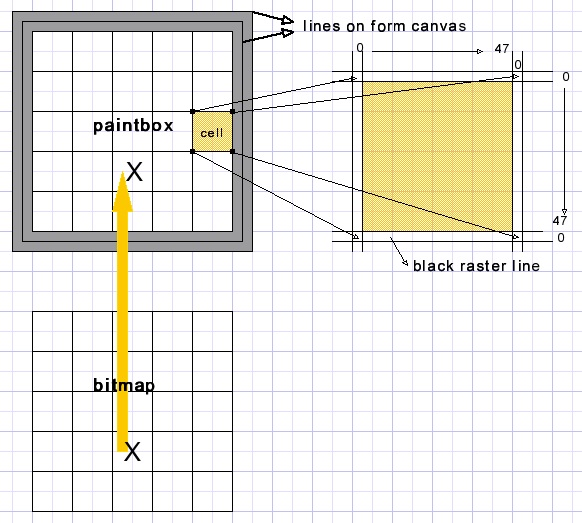
Cell data is stored in a one-dimensional array Game[ ].
type TCellstatus = (clClosed,clOpen,clQueen);
TCell = record
status : Tcellstatus;
region : byte;
colorNr : byte;
Gcol : byte;
Grow : byte;
Qlev : byte; //# queens closing cell
Hint : byte; //0: nono; 1:X; 2:Queen
...... end;
var game : array[1..144] of TCell;//maximum is 12*12 puzzle
gamesize : byte = 8;
gamesize2 : byte = 64;//gamesize*gamesize
Cells are counted 1...gamesize*gamesize: left to right, top to bottom.Around paintbox1 edges are paint on the form1 canvas.
procedure paintedges(ct : Tcontrol; w : byte; col : longword);
//line around control, penwidth w
var i : byte;
par : TComponent;
x1,y1,x2,y2 : word;
begin
par := ct.getParentcomponent;
with Tcustomform(par) do with canvas do
begin
x1 := ct.left-w;
y1 := ct.top-w;
x2 := ct.left+ct.width+w-1;
y2 := ct.top+ct.height+w-1;
pen.width := 1;
pen.color := col;
for i:= 0 to w-1 do
begin
moveto(x1+i,y1+i);
lineto(x1+i,y2-i);
lineto(x2-i,y2-i);
lineto(x2-i,y1+i);
lineto(x1+i,y1+i);
end;
end;
end;
Provide rectangle of a cell:
function Cell2Rect(nr : byte) : Trect; //nr : game cell nr var x,y : word; begin dec(nr); x := (nr mod gamesize)*48; y := (nr div gamesize)*48; result.Left := x + 1; result.Right := x + 47; result.Top := y + 1; result.Bottom := y + 47; end;Copy complete map or single cell to paintbox1:
procedure map2box; begin form1.gamebox.Canvas.Draw(0,0,map); end; ...... procedure Cell2Box(n : byte);//copy cell n to paintbox1 var r : Trect; begin r :=Cell2Rect(n); form1.gamebox.Canvas.CopyRect(r,map.Canvas,r); end;Regions are painted by
-
- selection of a color by mouseclick on the color box
- Move mouse over game paintbox while holding down the left-mousebutton.
The choice is of 15 colors in any sequence. (colorNrs 1..15).
For hint generation this is very inconvenient so, these color numbers are converted to
region numbers counting sequentially 1..gamesize.
This is done when switching from NEW to PLAY mode.
function MakeRegions : Ttestresult;Does the job. Testresult may indicate unassigned cells or the number of regions
being unequal to the gamesize.
Extra lines are painted between cells of different color.
This is done by:
procedure paintfences;
Data structures
type TCellstatus = (clClosed,clOpen,clQueen);//closed is X or Q
TCell = record
status : Tcellstatus;
region : byte;
colorNr : byte;//index into colorbox
Gcol : byte;//column of cell
Grow : byte;//row of cell
Qlev : byte; //# queens closing the cell
Hint : byte; //0: none; 1:X; 2:Queen
end;
ColorNr is the index of the color in the colorbox.Procedure EnterPlayMode calls function makeRegions : Ttestresult;
Tests for unassigned cells and also the number of regions being equal to the number of columns.
Gcol,Grow are the column and row numbers of teh cell (1..gamesize).
Qlev counts 1,2,... .
When AutoX is selected, placing a queen automatically places "X" s in cells of the same
column, row or region.
For these automaticalle closed cells Qlev is increased.
A cell may only be modified if Qlev=0. So all queens closing the cell have to be removed.
Calculate column and row from cell number:
procedure cell2CR(var C,R : byte; n : byte); //calc column (C), row (R) from cell (n) begin C := ((n-1) mod gamesize) + 1; R := ((n-1) div gamesize) + 1; end;
Testresult
type TTestresult = record
Scode : byte; //summary
Ecode : byte; //error code
n1,n2 : byte; //cells
end;
Scode values:
-
0 : OK
1 : unassigned cells (no region)
2 : region count unequal to gamesize
Connected cells
Cells that are in the same column, row, region or cells that touch diagonally are called "connected".
function connected(a,b : byte) : boolean;
var c1,c2,r1,r2 : byte;
begin
result := false;
if a=b then exit;
//
c1 := (a-1) mod gamesize;//Gcol,Grow used in later versions
r1 := (a-1) div gamesize;
c2 := (b-1) mod gamesize;
r2 := (b-1) div gamesize;
result := (game[a].region = game[b].region) or
(c1 = c2) or (r1 = r2) or
((abs(r1-r2) = 1) and (abs(c1-c2) = 1));
end;
Provides "true" if cells a,b are connected.Strategy
Function TestGame : Ttestresult does the job.Note : testresult values differ from previous values.
Scode:
-
bit 0: game OK
bit 1: game is full
bit 2: all queens placed
-
1 : column n1 is closed
2 : row n1 is closed
3 : region n1 is closed
5 : multiple queens in column n1
6 : multiple queens in row n1
7 : multiple queens in region n1
8 : touching queens in cells n1, n2
Queens is a logical puzzle.
The following rules apply:
-
1. Cells that connect to a queen cannot hold a queen.
2. If a column (or row) lies inside a region then all cells of the region outside the column(row) cannot hold a queen.
3. If a region lies within a column(row) then all cells of the column(row) outside the region cannot hold a queen.
4. Queens cannot be placed such that they close another column, row or region.
5. If n regions are positioned inside n colums(or rows) then any cell of other regions in these columns(rows) cannot hold a queen.
Some examples:
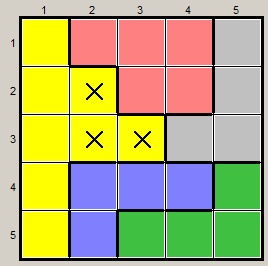 |
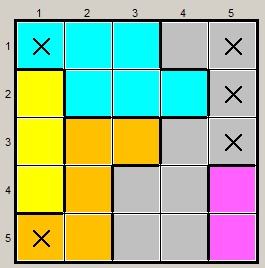 |
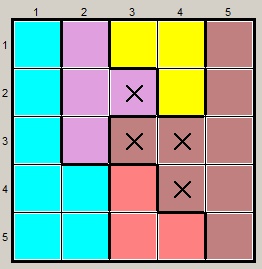 |
| yellow column within region | yellow,purple regions within column | yellow and red regions in columns 3,4 |
In the left image, "X" 's could be placed as well considering that
the red, grey, blue and green regions occupy the 4 columns 2,3,4,5.
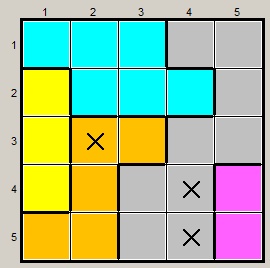 |
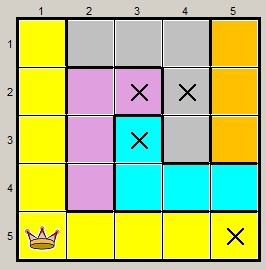 |
| X: queen would close region | only place for queen "X": queen would close region |
Warnings
Active in PLAY mode. Checks game after move for:-
multiple queen in column, row or region
full columns, rows or cells (no space to place queen).
This function also tests for solutions. See TTestresult codes before.
Hints
Hint search start by a clikck on the hint (lamp) button.procGametest is called and if no errors are detected procHints is called.
The hint procedures put their results in variable hintresult:
type THintResult = record
test : byte; //hint number
nr : byte; //cell
column : byte;
row : byte;
region : byte;
crg : word; //column,row,region bit vector
end;
There are 2 kind of hints: hintX idicates cell(s) that cannot hold a queen ("X").HintQ: cell that must hold a queen.
procHints calls:
-
procHint1: checks for open cells in columns, rows or regions that hold a queen.
-
calls functions testColumn, testRow,testRegion which return data in format TCRGstate
which is a SET of TCellstatus.
procHint31, procHint32, procHint33: test cell for queen closing a column (31), row (32) or region (33)
-
these procedures call functions checkColumnConnection(Xcolumn,cell)
checkRowConnection(Xrow,cell) and checkRegionConnection(Xregion,cell)
which return true if the cell connects to all cells in the column, row or region.
Thise is the more complicated part of the hints.
Let's have a closer view at procedure procHint51.
variable fullmask : word;has bits 1..n set for gamesize n.
var regioncolumns : array[1..gamesize] of word;bit c set in regioncolumns[r] means that region r has a cell positioned in column c.
Then k (2...gamesize-1) columns are selected by procedure combinations.
Look here for a description of the combinations generator.
A next (inner) loop selects k regions.
Selected columns and regions are bitwise coded (bit set if present).
Using predefined regionColumns and the selected combination, variable selRegions is made.
SelRegions has bit c set if the selected regions have an open cell in column c.
So, if selColumns = selRegions then in other regions of cells within the selected columns
and "X" may be placed.
This is done by procedure Xscan(selColumns,fullMask,XRegMask xor fullMask)
selcolumns: bit set if column selected.
fullmask: select all rows (in case of column testing)
Xregmask: bit set if region selected.
XregMask xor fullmask: alle regions that were not selected.
Xscan tests all cells and if criteria are satisfied, Hmarkcell(cell,1) is called to place an "X" in the cell.
note: 1: place X; 2: place queen.
I/O, save and open games
Queen files do not have an extention.Instead, the file name is prefixed by Q_ .
I/O is done by blockread and blockwrite procedures.
Before saving a game, cell data is entered in
var buffer : array[0..147] of longword;
bix : byte;
bix is the wordcount in the buffer.
I/O format (longwords)
0 ---- ---e ---- ---e ---- ---u ---- ---Q
1 --version ---- size ---- ---s ---- ---n
2 ---- Qlev ----color ---region ---status cell 1
3 .......................................
.... cell n*n
---f ---f ---0 ---0 ---0 ---0 ---0 ---0 end of data
function loadbuffer fills the buffer with game data,function UnpackBuffer supplies the data of the opened game.
Here follows the saveGame function:
function saveGame : byte;
var fname,fdir : string;
f : file;
xf : integer;
begin
result := 2;
clearbuffer;
loadbuffer;
with form1.savedialog1 do
if execute then
begin
result := 1;
fname := ExtractFileName(filename);
fdir := ExtractFileDir(filename);
if pos('Q_',fname) <> 1 then insert('Q_',fname,1);
filename := fdir + '\'+ fname;
{$I+}
try
assignfile(f,filename);
rewrite(f,4); //4: record size
blockwrite(f,buffer,bix,xf);
result := 0;
finally
CloseFile(f);
end;
end;
end;
This concludes the Queens Delphi project description.
